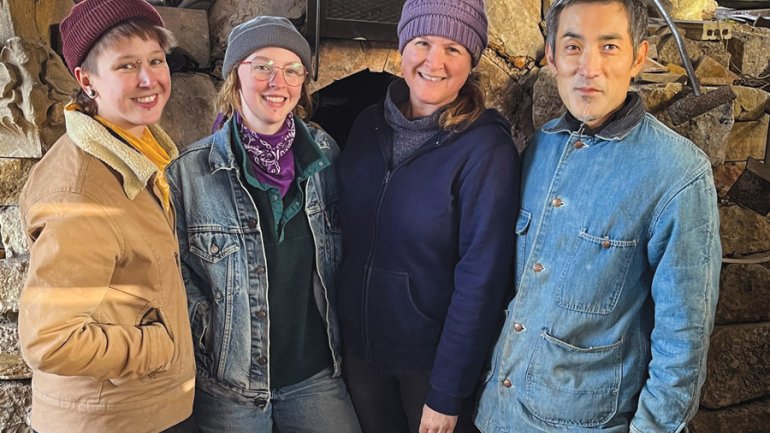Kilns That Build Community
Kilns That Build Community
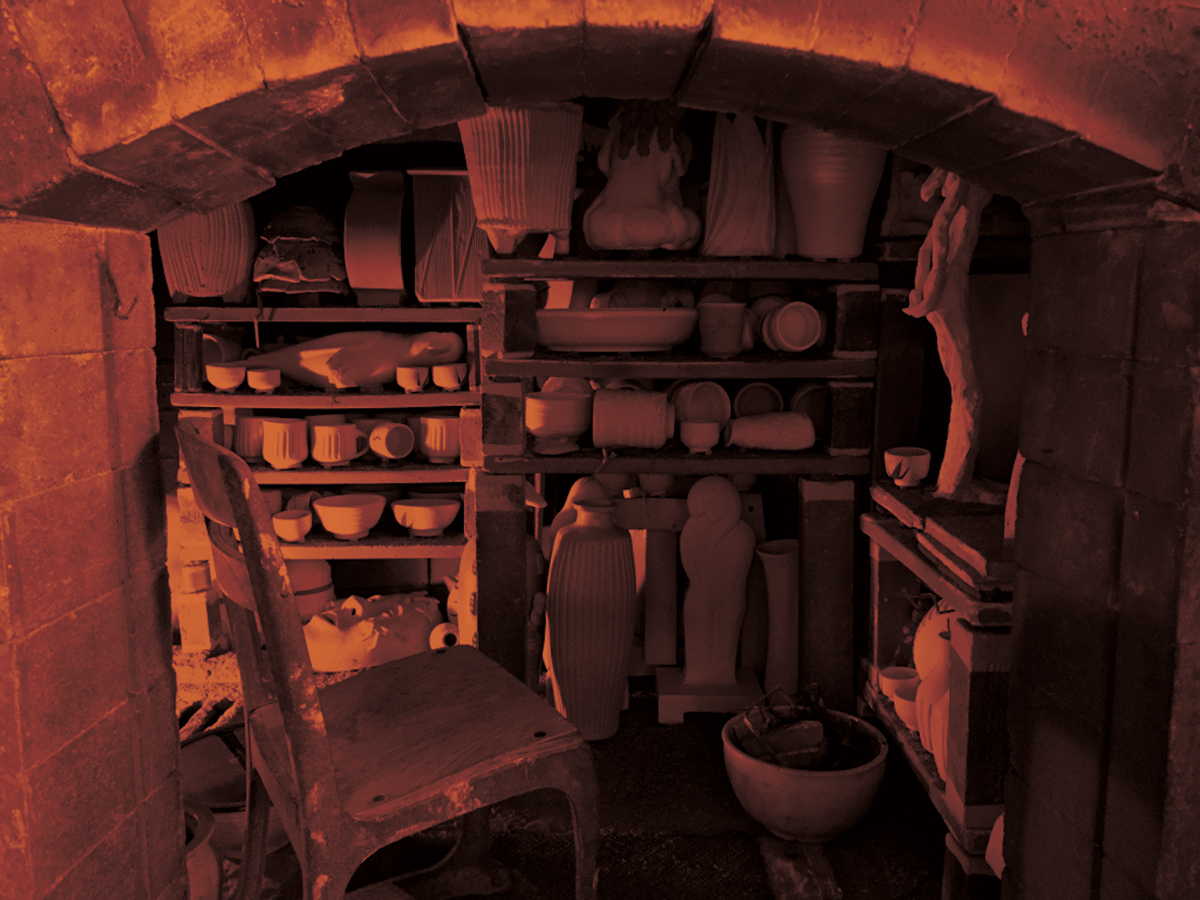
One of Conrad Calimpong’s Ferndale, California, kilns fully stacked with ceramics from multiple artists participating in the firing. Photo by Conrad Calimpong.
“Off the bat, they were doing a wood-firing—all these people I didn’t know, from many different backgrounds, from North Carolina, Japan, India,” Oakley recalls. “I was only 19, and I’m learning tips from people twice my age.” The group built another kiln, and the next year, Schwartz and Thompson invited Oakley back. She spent another idyllic summer by the fire, sharing meals with other artists, picking fruit, and cooling off by the river.
“Those two summers changed my whole life,” she says. “Before firing with Nick, I didn’t know who I was or what I wanted. When we’re wood-firing, we have our purpose. It doesn’t matter where you come from, what you do. All of that goes away, and you need to watch this fire.”
Tradition Revived
People have gathered around flames for millennia to fire ceramics with wood, watching as heat and ash mingle to leave singular marks on wares—glazes that are wholly natural. Originating in Southeast Asia and East Asia, the ancient tradition has survived despite the invention of gas and electric kilns. In recent years, it has even flourished. “The proliferation of wood kilns is so different from when I started in 1985—there were hardly any,” says Conrad Calimpong, who has kilns in Ferndale, California. “And now there’s hundreds.”
There are no official statistics on the number of wood kilns in the United States, but Illinois-based potter Simon Levin has been crowdsourcing a searchable map of them that illustrates their vast geographic spread (see simonlevin.com/map). Some are owned by schools and open mostly to students; others, like East Creek Anagama in Oregon, are community-based and host public workshops. Many are privately owned and were built to fire one artist’s ceramics.
—Jasmine Oakley
_2.jpg)
Jasmine Oakley and other students witness the final stoke of a seven-day anagama firing in 2018 at Eckerd College in St. Petersburg, Florida. Photo by Jasmine Oakley.
The job, however, cannot be done solo. Kilns must be fired nonstop for days, sometimes for more than one week, requiring constant vigilance as flames dance around the wares. A rotating crew of stokers works in shifts that may last as long as 8, even 12, hours. Many kiln owners, like Schwartz and Thompson who now run Cider Creek Collective, invite artists to share kiln space in exchange for their labor; some also rent out space to cover material costs. Naturally, many kilns have evolved into community hubs, drawing regulars who reunite by the mesmerizing blaze.
“Deep friendships have been formed around the kiln and, in fact, a couple marriages,” says Schwartz, who has led community firings for three decades. “It teaches people how to communicate, how to solve problems together, conflict resolution.”
The process of wood-firing, from prep to cleanup, can take upwards of a month depending on the kiln type and size. There’s the noborigama, a traditional Japanese multi-chambered kiln for large-scale production that is designed to ascend a slope. One modern, time-saving option is the train kiln, whose structure recalls a locomotive and can be fired for one or two days. Perhaps the most popular structure is another traditional Japanese kiln, the anagama, an elongated dome–shaped furnace. “What sets it apart is that it takes full advantage of the wood-fire aesthetic because the fire is in direct contact with clay,” Schwartz says. “You get these massive ember beds that create an aesthetic you can’t really get any other way.”
Around the Kiln, Around the Clock
The hard work of hardening clay begins long before a flame is lit. Firewood prep happens weeks, sometimes months, ahead, involving wood collection, then splitting pieces into manageable sizes. Next comes loading, a strategic operation that can take as long as two to four days and involve more than a thousand clay works. Ceramics nestle side by side, crammed onto shelves, every placement determining their final aesthetics. “The flame is like a glacial river, splitting, merging, and flowing, and you’re trying to create obstacles for the fire to change paths and go certain ways,” says Cynthia Morelli, who owns a kiln in Homer, Alaska. “You can work to get a load that enhances the works in the best possible way.”
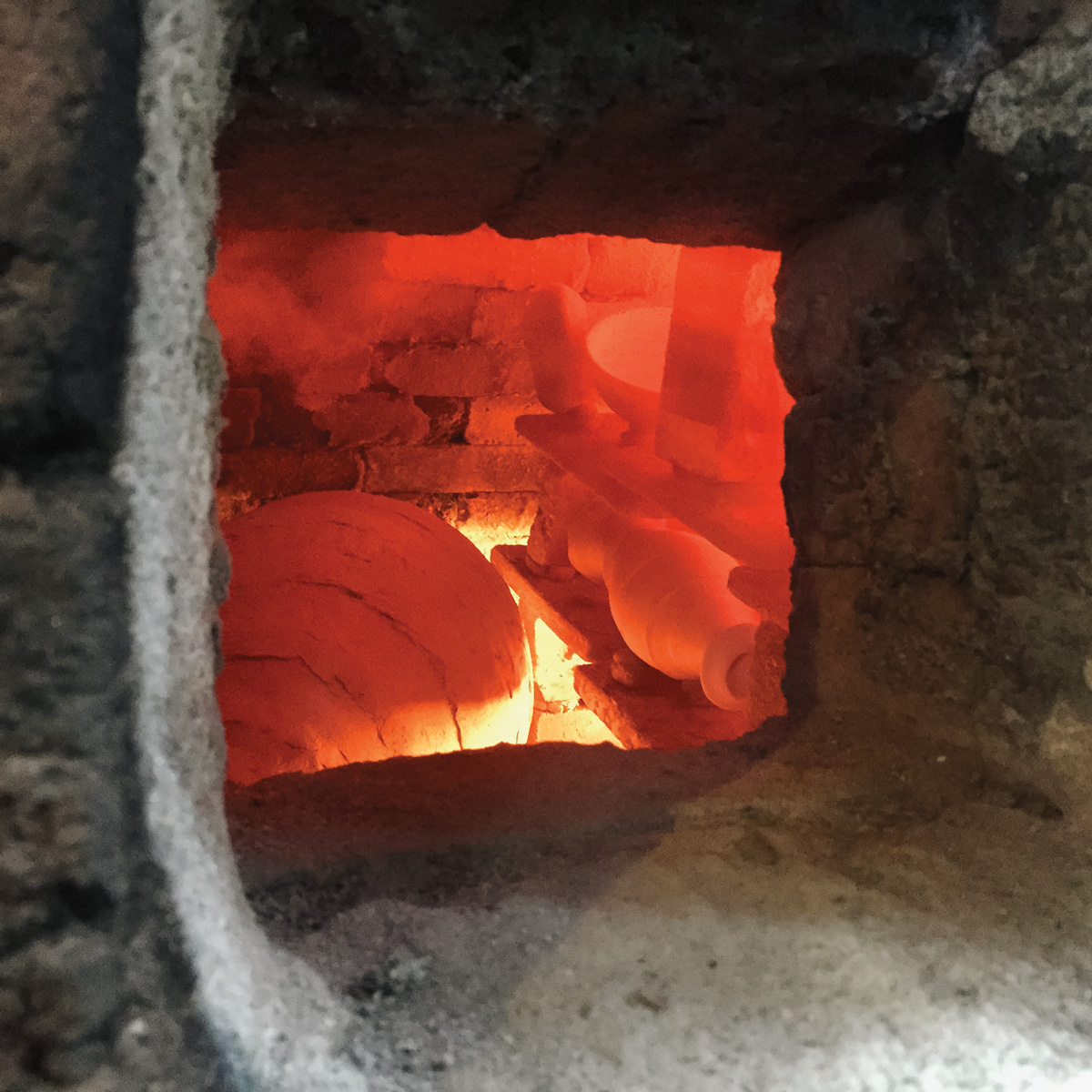
—Nick Schwartz
Generally, greater color change happens as clay is increasingly exposed to heat. Encrusted patterns form as ash accumulates on surfaces, melts, and drips. Striking effects can transpire from the flashing of flames between pieces. Though the results are impossible to predict, stokers wield some degree of influence. They make adjustments depending on conditions such as temperature fluctuations, oxygen levels, how quickly wood is consumed, even the color of smoke. During a shift, one nurses the fire as frequently as every three to five minutes, aiming to hit certain temperature goals in different areas of the kiln.
TOP LEFT: Work heating up inside an anagama kiln run by Nick Schwartz on California’s Mendocino coast. Photo by Nick Schwartz.
TOP RIGHT: Anandamayi Arnold (left) and Nick Schwartz looking at a new pot from the anagama kiln. Photo by Jess Thompson.
BOTTOM RIGHT: Students in a Florida wood-fire kiln building class—run by Schwartz and Brian Ransom—look at their work after it’s removed from the kiln. Photo by Jasmine Oakley.
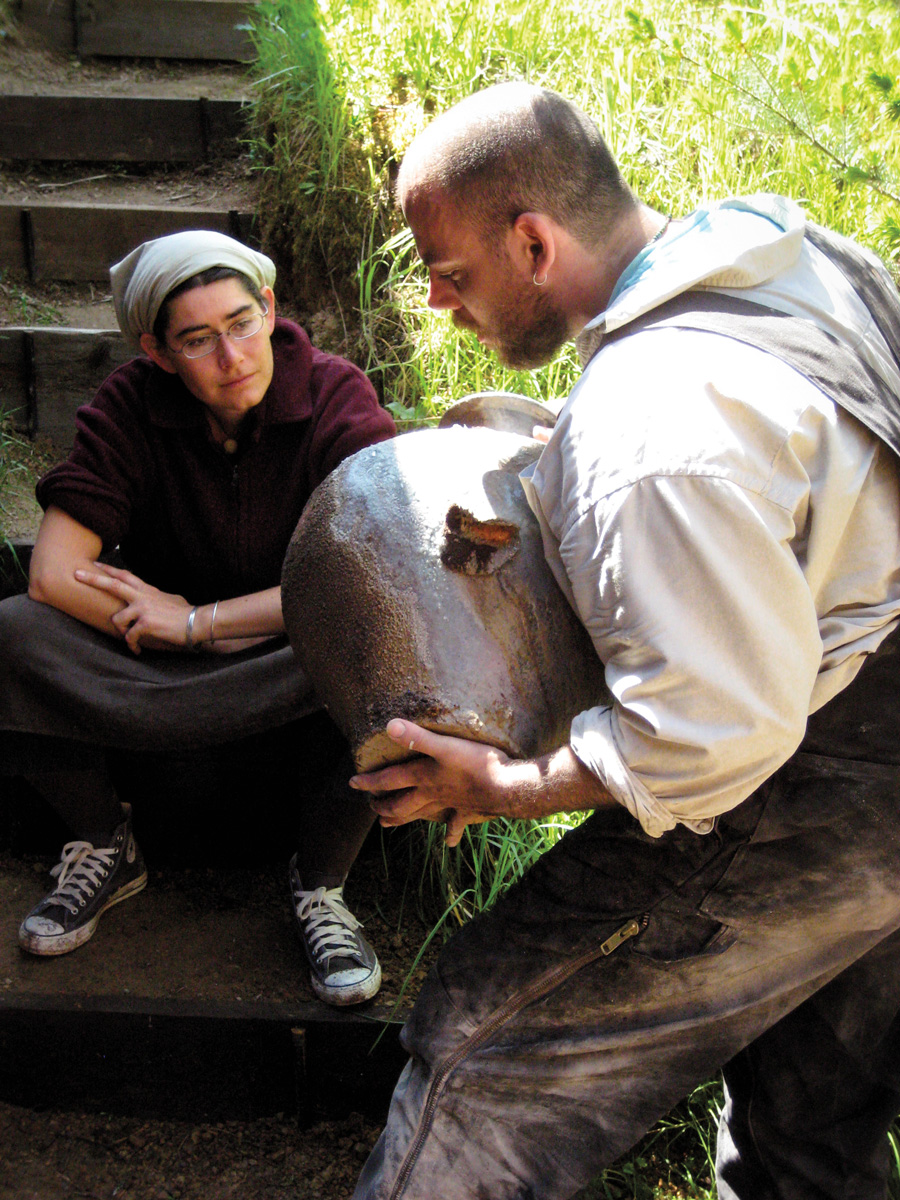
_2_Recorrected.jpg)
“We’re trying to read the kiln constantly,” says Samuel Johnson, a professor at the College of Saint Benedict and Saint John’s University in central Minnesota, who built an anagama kiln on campus in 2012. “I listen constantly for the sound of combustion, for the sound of air moving through to the fire.”
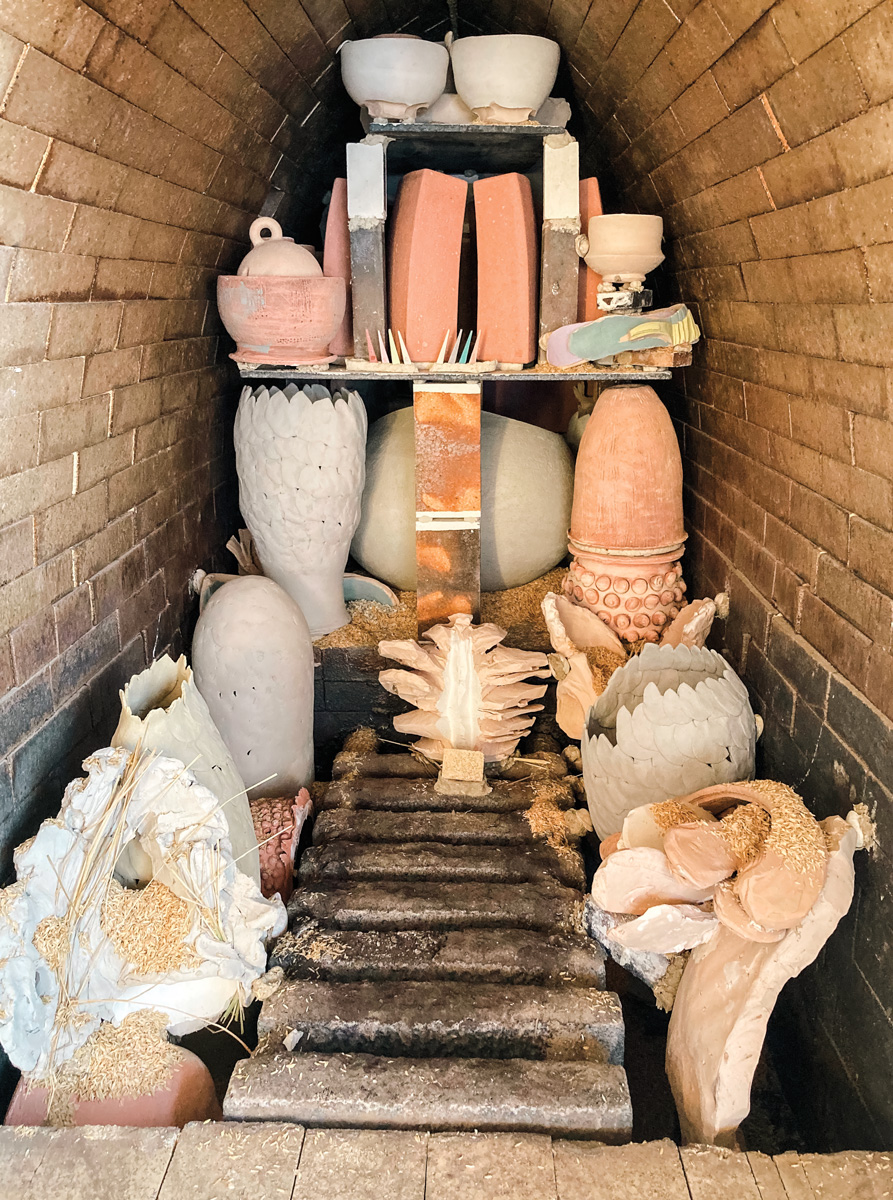
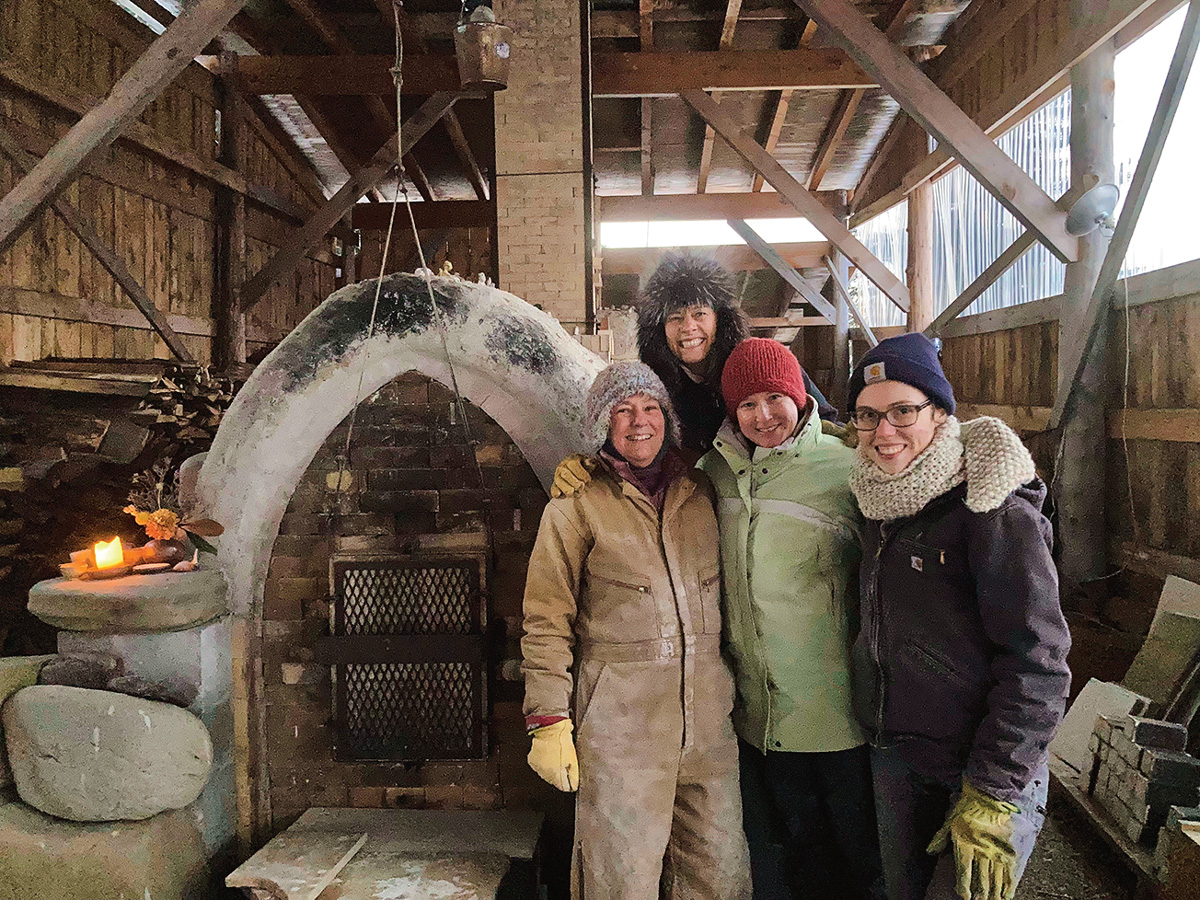
LEFT: Cynthia Morelli’s Mamagama, a “tube-style” anagama kiln, loaded up at her studio in Homer, Alaska. ABOVE: Morelli (left) and resident artists Amanda Gentry, Heidi Kreitchet, and Zoë Powell, ready to start a November 2021 firing in subzero temperatures. Photos courtesy of Cynthia Morelli.
—Cynthia Morelli

Work by Morelli and Kreitchet after it was unloaded from the kiln. Photo by Zoë Powell.
When the flame is out—whether after 3 days or 10—the crew can recharge as the kiln cools. After about a week, the work recommences as they unload the goods, like archaeologists excavating treasures in an ancient, dusty chamber. This, too, must be done carefully to avoid breakage. (Although wadding, a refractory clay material, is placed around every piece during loading to prevent works from sticking, bonding still occurs. Separation may be achieved by sanding or grinding the pottery.) Finally, the crew cleans the kiln and polishes their creations.
—Samuel Johnson
The process is exhausting and at times brutal. To many wood-firers, it is also sacred, a kind of ritual steeped in history and tradition. Oftentimes, firings even begin with an offering to the kiln: flowers, or a splash of sake or whiskey into its mouth. “There’s a deep sense of camaraderie, but also respect for what’s going on—a kind of soberness,” Johnson says. “The firing cannot be ignored. There is a sense of, Okay, we’re in this together. And we’re going to do it in the middle of the night. We might be doing it during a blizzard. Or on 100-degree days. And if it’s hard, it doesn’t matter, because we’re going to be doing this.”
Fêtes by the Fire
It helps that wood-firings are also fun. The occasion is not unlike a creative retreat or an art camp. As temperatures inside the kiln climb to more than 2000 ̊F, artists may be hanging out nearby drinking tea, preparing meals together, or exchanging life stories. People may pitch tents on the grounds while others bunk in the host’s home. “Everything is dropped by the wayside while the firing is happening,” Morelli says. “I think that it really is a bonding experience for the people involved. It takes you to another place.”
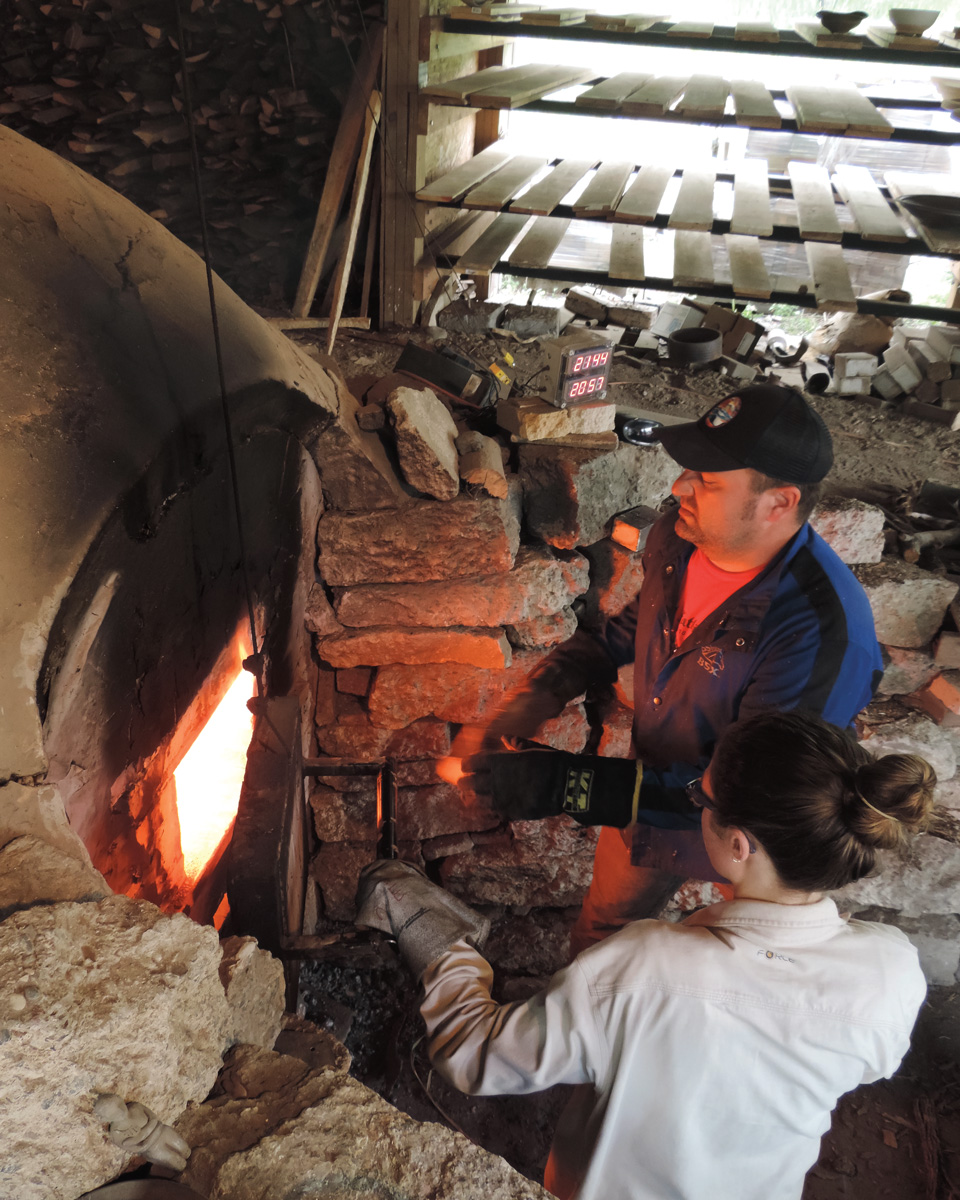
Artist Zoë Powell and K–12 art teacher Mike Carlson at a firing of the Sister Dennis Frandrup Wood Kiln, part of Minnesota’s College of Saint Benedict and Saint John’s University. “Partnering artists and art educators is one of the ways that this community firing connects members of our art community and models collaboration and mutual support for our students,” says ceramist Samuel Johnson, who hosted the event. Photo courtesy of Mitch Iburg & Zoë Powell.
In fact, no one really ever wants to leave the blaze, Oakley says, whether or not they are on a shift.“We find things to do around the kiln, and that’s our party. While people are loading or stoking, there’s this huge table where everyone brings dishes, and it’s a gathering of food and culture.”
—Conrad Calimpong

Participants gather with food near Calimpong’s kilns. Photo by Conrad Calimpong.
That mingling of perspectives is reflected inside the kiln, where pottery of all styles undergoes collective transformation. A single kiln may hold large urns, small bottles and bowls, and abstract clay shapes. Some may be glazed, though many artists prefer to embrace the natural glazing from ash, which can produce rich earth tones and an exquisite weathered look. Part of the intrigue is getting to see how other potters work and observe how a particular firing can influence one’s own practice. Artists surrender control to the process, allowing the elements to take charge. “I find it really liberating for a lot of people, especially artists who spend a lot of time in the studio,” Schwartz says. “They realize, Wow, there’s a creative dialogue happening, and all of a sudden my work is changing based on what I see other people doing and how they talk about their work.”
The experience can also be life-affirming as artists discuss their creative lifestyles. Johnson says such conversations are especially impactful for his students. “They’re surrounded with people who have dedicated their life to a world of aesthetics and art, and suddenly, it’s all within reach,” he says. “They see these meaningful, deep life choices playing out.”
Destination Firings
The hugeness of undertaking a wood-firing limits how often they can happen. Artists cranking out pottery may follow a cycle as short as six to eight weeks, according to Schwartz, and hire stokers. But it’s also common for some to light their kilns just two or three times a year. Such wood-firings tend to be invitation-only or heard about through word of mouth (although many kiln owners also schedule firings with visiting artists that are open to anyone curious). Calimpong says he notifies friends months in advance of his interest in organizing firings at his Ferndale kiln, then works around their availability. Many attendees are regulars, including his first ceramics teacher, who has been showing up for a decade. Sometimes artists will bring friends, widening the circle of collaborators. They may have different skill levels and be guests at a kiln, but “we’re all on the same level, the same playing field,” Oakley says. “I’ve always felt comfortable at wood-fire gatherings.”
Potter Shumpei Yamaki, who fires his kiln near West Branch, Iowa, twice a year, operates with a democratic spirit. “I own a kiln, but it’s not just my kiln,” he says. “I don’t put my name first. I like to cultivate the idea of sharing. My philosophy is that a great community and a great team can produce better results because you can have a great vibe.” This shared time, he adds, ideally gives artists reason to return to his studio and develop more projects together, whether firings or an exhibition.
For young potters in particular, the experience can provide opportunities to learn from seasoned ceramists, lead to exhibitions, and increase access to other kilns. “A lot of students who are first-time firers use this experience as a jumping board. When they go to another kiln, if the person knows who I am, that kind of gives them a foot in the door,” Calimpong says. “You can create a network.”

—Shumpei Yamaki
A stack of wood ready for a firing at one of Conrad Calimpong's kilns in Ferndale California. Photo by Conrad Calimpong.
Kilns tend to be in remote locations—there’s less chance, after all, of someone calling the fire department. Participants, therefore, often come from out of town, even outside the country. Calimpong has hosted people from as close as the San Francisco Bay Area to as far as Hungary and Germany. Artists often drive hours with their work or have pieces shipped, sometimes as bisqueware, which is fired at a lower temperature for durability.
Visiting different kilns takes commitment, but doing so enhances a potter’s perspective, as no two firings are the same. Plus, kilns produce varied effects depending on their architecture and firing team. “Each person fires a kiln very differently, so you get the beautiful opportunity to peer into someone’s insight, experience, and instinct,” Oakley says. “Each kiln has its own personality.”
Two years out of college, Oakley has built a half-dozen kilns since her first encounter with wood-firing. She is now designing her own to stand on her family’s land in Middlesex County, Virginia, using bricks made from local clay. Although she has been flying to Florida to lead firings at her alma mater, she wants to create something nearby that carries her own character—and a place where she can develop another legacy.
Wood-firing, she says, “led to me coming home to myself and my identity.” She wants to help other artists feel a similar sense of belonging. “Through wood-fire, you find your family, because you have people who understand you in a way that no one else does—the primitive side of you, the side that gets delirious because you’ve been up all night,” Oakley says. “It’s not just about putting a piece in the kiln. It’s like people are putting you back together. Your identity is reshaping because, finally, some- one understands you in different ways. They see me.”

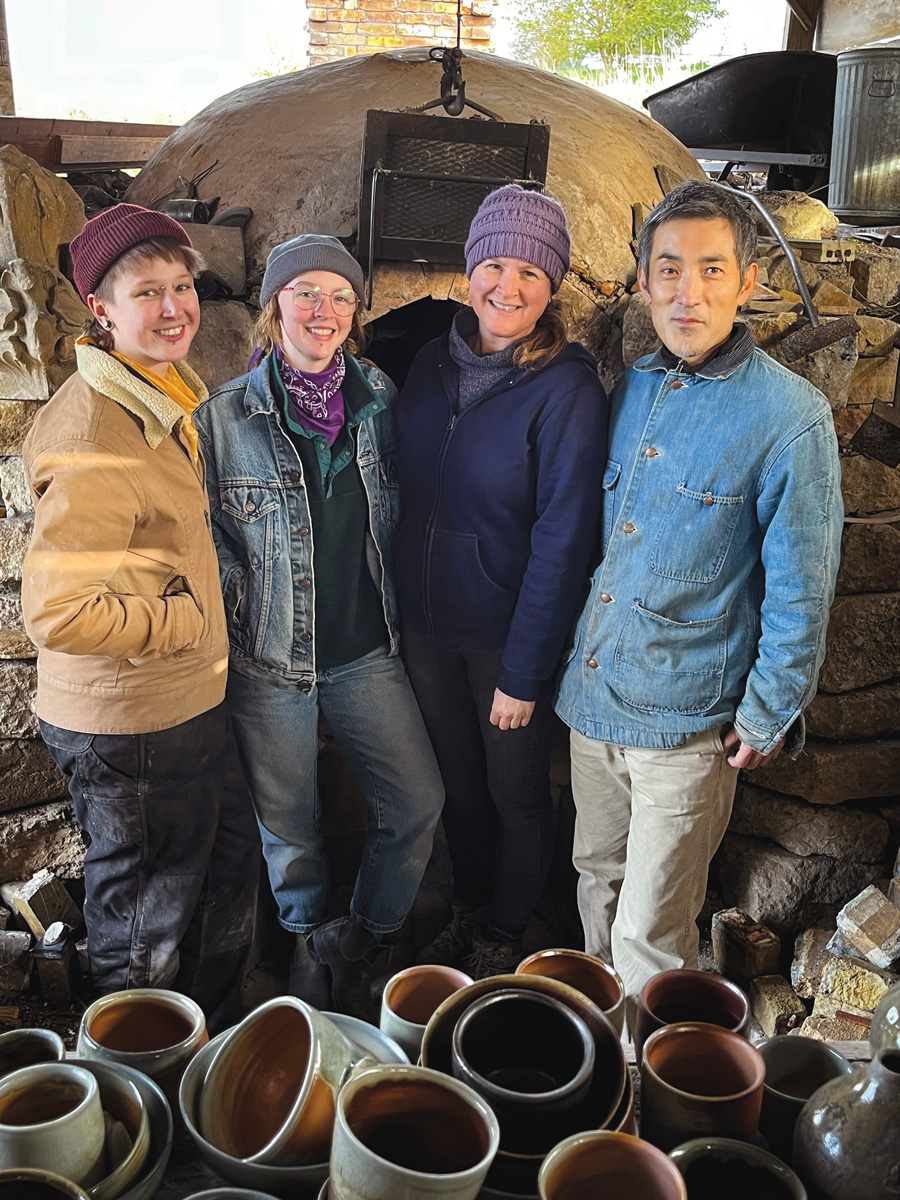
TOP: A batch of ceramics from a 2022 firing ready to be unloaded from Shumpei Yamaki's kiln in West Branch, Iowa. Photo by Shumpei Yamaki. BOTTOM: Tab Link (left), Meg Billingham, Jess Lease, and Shumpei Yamaki in front of Yamaki’s kiln at a 2021 firing. Photo by anonymous, courtesy of Shumpei Yamaki.
Discover More Inspiring Artists in Our Magazine
Become a member to get a subscription to American Craft magazine and experience the work of artists who are defining the craft movement today.


